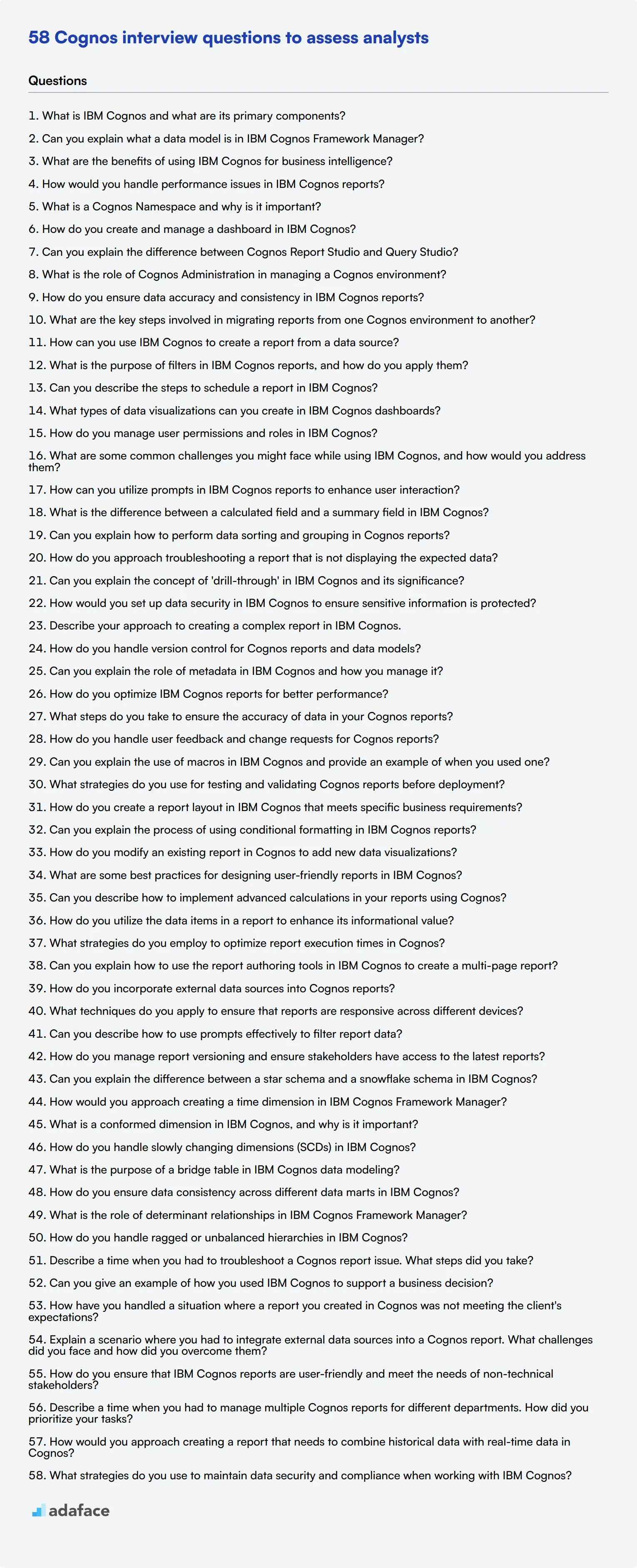As a hiring manager or recruiter, you already know that asking the right questions during an interview is crucial to identifying top talent. This post will help you navigate the interview process by providing a list of IBM Cognos interview questions tailored to different levels of expertise.
This blog post will cover a variety of questions, from basic to situational, aimed at assessing candidates' proficiency with IBM Cognos. We have categorized them into sections for junior analysts, mid-tier analysts, reporting techniques, and data modeling to streamline your interviewing process.
Using this list, you'll be able to effectively assess candidates' skills and knowledge in IBM Cognos. Additionally, enhance your hiring process by starting with a relevant data analysis test from our test library before conducting interviews.
Table of contents
10 basic IBM Cognos interview questions and answers to assess candidates
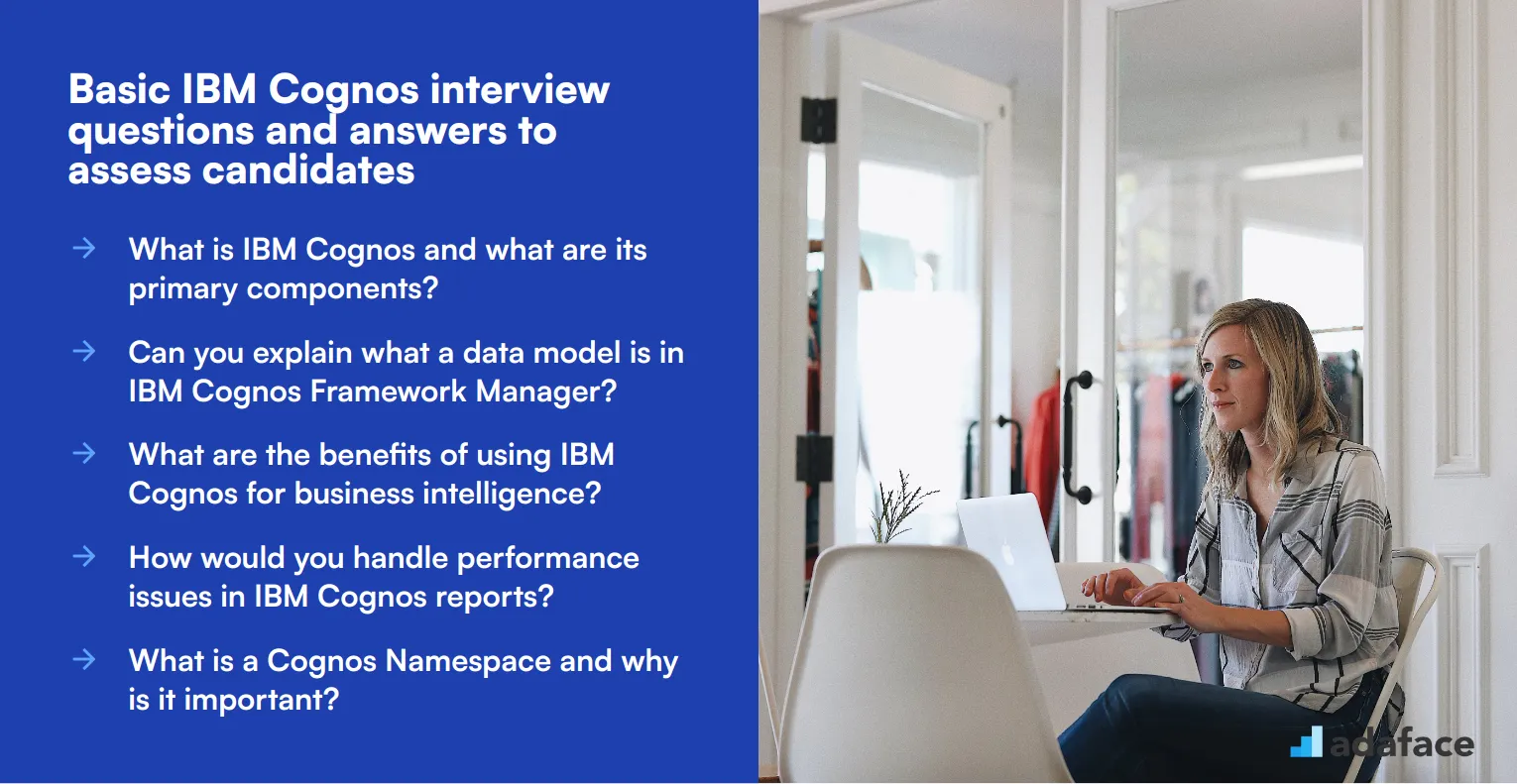
To assess if your candidates have a solid grasp of IBM Cognos, these 10 basic interview questions are a great starting point. They will help you gauge fundamental knowledge and suitability for various roles involving IBM Cognos.
1. What is IBM Cognos and what are its primary components?
IBM Cognos is a business intelligence and performance management suite designed to help organizations make informed decisions. It offers a range of tools for reporting, analysis, scorecarding, and monitoring events and metrics.
The primary components include: Cognos Connection (the web portal), Cognos Administration (administration and monitoring), Cognos Framework Manager (for creating metadata models), Cognos Report Studio (for creating complex reports), and Cognos Analysis Studio (for exploring and analyzing data).
Look for candidates who can clearly articulate these components and explain their basic functions. This shows they are familiar with the overall architecture and capabilities of IBM Cognos.
2. Can you explain what a data model is in IBM Cognos Framework Manager?
A data model in IBM Cognos Framework Manager is a metadata layer that defines the structure and relationships of data sources. It maps the physical data to a logical model, which is then used to create reports and analyses.
The data model includes objects such as namespaces, query subjects, query items, relationships, and filters. It helps users access and understand the data without needing to know the complexities of the underlying databases.
Ideal responses will include an explanation of the components and importance of the data model. Candidates should highlight their experience in designing and maintaining data models to ensure data accuracy and performance.
3. What are the benefits of using IBM Cognos for business intelligence?
IBM Cognos provides a centralized platform for reporting, analysis, and performance monitoring, which helps organizations make data-driven decisions. It offers flexibility and scalability, allowing businesses to adapt as their data needs grow.
Key benefits include real-time reporting, interactive dashboards, predictive analytics, and collaborative features. These tools help improve decision-making, streamline processes, and enhance overall business performance.
Strong candidates will mention specific features and benefits and may provide examples of how they've utilized IBM Cognos in previous roles to drive business value.
4. How would you handle performance issues in IBM Cognos reports?
To handle performance issues in IBM Cognos reports, one should start by analyzing the report design and data model. Identify any inefficient query structures, unnecessary data retrieval, or complex calculations that could be optimized.
Steps to improve performance may include: indexing key columns in databases, using filters to limit data retrieval, splitting complex reports into simpler sub-reports, and optimizing report queries.
Candidates should demonstrate a methodical approach to troubleshooting and optimizing reports. Look for those who can provide specific examples of performance issues they've resolved and the techniques they used.
5. What is a Cognos Namespace and why is it important?
A Cognos Namespace is a container within IBM Cognos that holds different types of objects, such as users, groups, and roles. It helps organize and secure access to data and reports by defining permissions and access rights.
Namespaces are crucial in managing user authentication and authorization, ensuring that only authorized individuals have access to specific data and functionalities.
Ideal candidates will explain the role of namespaces in security and organization within IBM Cognos. They should also discuss their experience in setting up and managing namespaces to ensure data integrity and compliance.
6. How do you create and manage a dashboard in IBM Cognos?
Creating a dashboard in IBM Cognos involves selecting and arranging various widgets, such as charts, graphs, and tables, to visualize data insights. You can use Cognos Workspace or Cognos Dashboarding tools for this purpose.
The process includes defining data sources, setting up visualizations, configuring filters, and customizing the look and feel of the dashboard. Managing a dashboard involves regularly updating data, refining visualizations based on user feedback, and ensuring performance optimization.
Look for candidates who can describe their experience in designing user-friendly and interactive dashboards. They should provide examples of how they have used dashboards to facilitate decision-making and improve business outcomes.
7. Can you explain the difference between Cognos Report Studio and Query Studio?
Cognos Report Studio is a powerful tool for creating complex, professional reports with advanced formatting, calculations, and interactive features. It's designed for professional report authors who need to create highly customized reports.
Query Studio, on the other hand, is a simpler tool for creating ad-hoc queries and basic reports. It allows users to quickly retrieve and analyze data without needing advanced report authoring skills.
Candidates should highlight their understanding of both tools and their appropriate use cases. They might also discuss their experience using these tools in different scenarios to meet various reporting needs.
8. What is the role of Cognos Administration in managing a Cognos environment?
Cognos Administration is a component that allows administrators to manage the Cognos environment, including user access, server configuration, and system monitoring. It provides tools for scheduling reports, managing user permissions, and monitoring system performance.
Administrators can use this tool to ensure the smooth operation of the Cognos environment, troubleshoot issues, and optimize system performance.
Ideal candidates will discuss their experience in using Cognos Administration to manage users, configure servers, and monitor system health. Look for examples of how they've ensured system reliability and user satisfaction.
9. How do you ensure data accuracy and consistency in IBM Cognos reports?
Ensuring data accuracy and consistency in IBM Cognos reports involves validating data sources, designing accurate data models, and implementing robust data governance practices. Regular data validation and testing are also essential.
Best practices include using standardized naming conventions, maintaining clear documentation, and conducting thorough data quality checks. Collaboration with data owners and stakeholders is critical to address any discrepancies.
Candidates should demonstrate their commitment to data quality and discuss specific techniques they use to ensure accuracy and consistency. Look for examples of how they've identified and resolved data issues in previous roles.
10. What are the key steps involved in migrating reports from one Cognos environment to another?
Migrating reports from one Cognos environment to another involves several key steps: exporting the reports, importing them into the target environment, and validating the migration to ensure everything works as expected.
The process includes backing up existing reports, adjusting any environment-specific settings (like data source connections), and thoroughly testing the reports in the new environment to identify and fix any issues.
Ideal candidates will describe their experience with report migration and highlight any challenges they faced and how they overcame them. Look for those who emphasize planning, testing, and validation to ensure a smooth migration.
10 IBM Cognos interview questions to ask junior analysts
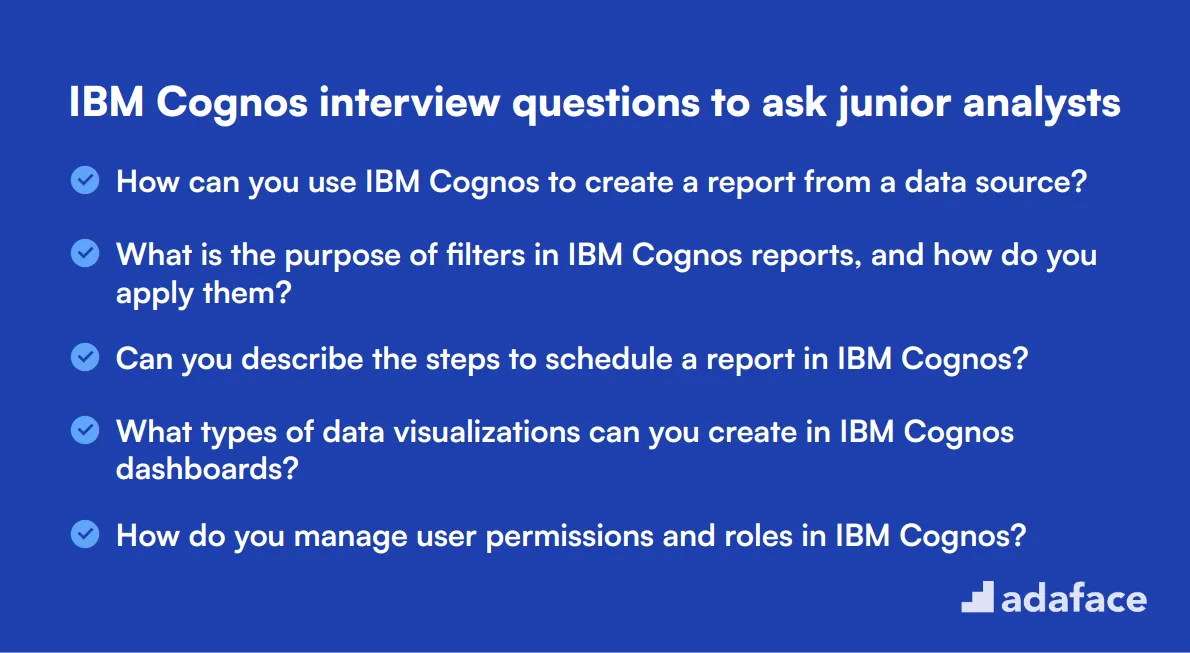
To effectively gauge the capabilities of junior analysts in IBM Cognos, consider using this carefully curated list of interview questions. These questions will help you assess not only their technical understanding but also their problem-solving skills in practical scenarios. For a comprehensive understanding of their role, refer to our business intelligence analyst job description.
- How can you use IBM Cognos to create a report from a data source?
- What is the purpose of filters in IBM Cognos reports, and how do you apply them?
- Can you describe the steps to schedule a report in IBM Cognos?
- What types of data visualizations can you create in IBM Cognos dashboards?
- How do you manage user permissions and roles in IBM Cognos?
- What are some common challenges you might face while using IBM Cognos, and how would you address them?
- How can you utilize prompts in IBM Cognos reports to enhance user interaction?
- What is the difference between a calculated field and a summary field in IBM Cognos?
- Can you explain how to perform data sorting and grouping in Cognos reports?
- How do you approach troubleshooting a report that is not displaying the expected data?
10 intermediate IBM Cognos interview questions and answers to ask mid-tier analysts
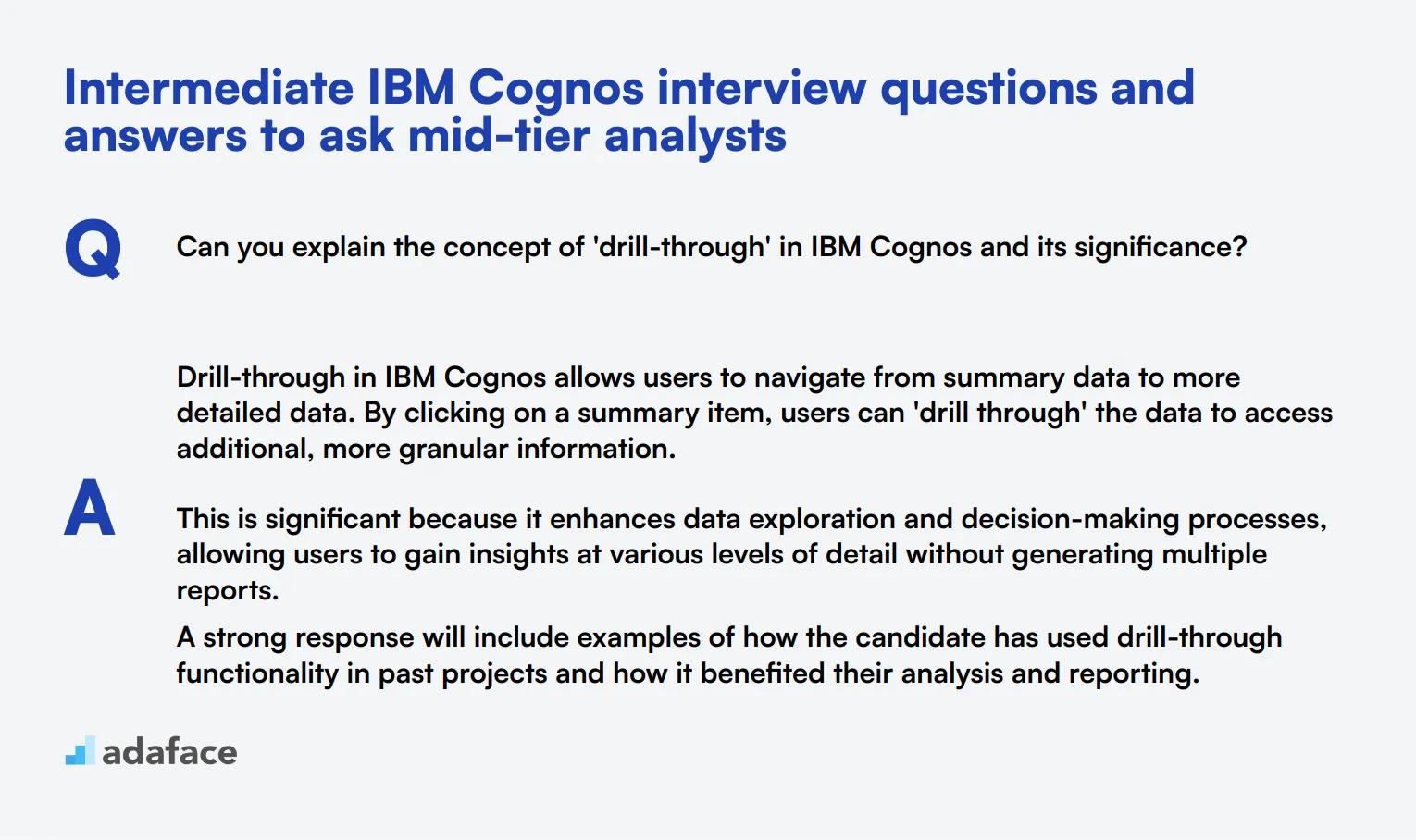
To ensure your mid-tier analysts are well-versed in IBM Cognos, this curated list of intermediate questions will help you gauge their proficiency. These questions are perfect for diving deeper into their practical knowledge and experience with the platform.
1. Can you explain the concept of 'drill-through' in IBM Cognos and its significance?
Drill-through in IBM Cognos allows users to navigate from summary data to more detailed data. By clicking on a summary item, users can 'drill through' the data to access additional, more granular information.
This is significant because it enhances data exploration and decision-making processes, allowing users to gain insights at various levels of detail without generating multiple reports.
A strong response will include examples of how the candidate has used drill-through functionality in past projects and how it benefited their analysis and reporting.
2. How would you set up data security in IBM Cognos to ensure sensitive information is protected?
Data security in IBM Cognos can be set up using a combination of roles, groups, and permissions. By assigning specific access rights to different user groups, you can control who can view, edit, or interact with particular data sets.
It's crucial to define appropriate security policies in the Cognos Administration tool and utilize namespaces to manage user access effectively.
Look for candidates who can articulate the importance of maintaining data security and provide examples of security measures they have implemented in previous roles.
3. Describe your approach to creating a complex report in IBM Cognos.
Creating a complex report in IBM Cognos involves multiple steps: understanding the requirements, designing the data model, creating queries, and finally, building the report layout. It's essential to ensure that the data model supports the required analysis and that the queries are optimized for performance.
The process also includes testing the report thoroughly to ensure accuracy and making necessary adjustments based on feedback.
Ideal candidates should demonstrate a structured approach to report creation and highlight how they ensure the report meets business needs while maintaining performance and accuracy.
4. How do you handle version control for Cognos reports and data models?
Version control for Cognos reports and data models typically involves using a source control system such as Git or SVN. This allows analysts to track changes, collaborate more effectively, and revert to previous versions if needed.
It's vital to implement a versioning strategy that includes clear naming conventions and documentation to keep track of updates and modifications.
Candidates should provide examples of version control practices they have used and discuss the benefits of maintaining a structured version control system.
5. Can you explain the role of metadata in IBM Cognos and how you manage it?
Metadata in IBM Cognos refers to the data that defines other data, essentially serving as a roadmap for how data is stored, organized, and interpreted. It includes information about data sources, relationships, and data models.
Managing metadata involves creating and maintaining data models in the Framework Manager, ensuring they accurately represent the underlying data and support the required reporting and analysis.
A good candidate should highlight their experience with metadata management and explain how they ensure its accuracy and relevance for business intelligence purposes.
6. How do you optimize IBM Cognos reports for better performance?
Optimizing IBM Cognos reports involves several techniques such as limiting the amount of data retrieved by using filters, optimizing queries, and leveraging caching mechanisms. It's also important to design efficient data models and ensure the underlying database is well-tuned.
Regularly reviewing and refining reports to eliminate unnecessary calculations and data retrievals can also contribute significantly to performance improvements.
Look for candidates who can provide specific examples of performance optimization techniques they have employed and the impact these had on report efficiency.
7. What steps do you take to ensure the accuracy of data in your Cognos reports?
Ensuring data accuracy involves validating data sources, conducting thorough testing of data models and reports, and implementing automated data quality checks. Cross-referencing report outputs with source data and performing regular audits are also essential.
It's important to establish a robust data governance framework that includes clear definitions, standards, and processes for maintaining data quality.
Candidates should discuss their experience with data validation and quality assurance practices, highlighting specific methods they use to ensure data accuracy in their reports.
8. How do you handle user feedback and change requests for Cognos reports?
Handling user feedback and change requests involves setting up a structured process for collecting, prioritizing, and implementing changes. This typically includes gathering detailed requirements, assessing the impact of changes, and communicating timelines to stakeholders.
It's important to maintain a balance between addressing user needs and ensuring the stability and performance of existing reports.
Ideal candidates will demonstrate their ability to manage change requests effectively, highlighting their communication skills and examples of successfully implemented changes based on user feedback.
9. Can you explain the use of macros in IBM Cognos and provide an example of when you used one?
Macros in IBM Cognos are used to dynamically alter SQL queries or report behavior at runtime. They can be employed to create more flexible and reusable reports by incorporating variables and conditional logic.
For example, a macro can be used to automatically adjust the report's time frame based on the current date or user input.
Candidates should provide specific examples of how they have used macros to solve business problems, demonstrating their understanding of this powerful feature and its practical applications.
10. What strategies do you use for testing and validating Cognos reports before deployment?
Testing and validating Cognos reports involves several strategies, including unit testing individual report components, performing end-to-end tests with actual data, and conducting user acceptance testing (UAT) with stakeholders.
It's also crucial to implement automated testing where possible and to maintain comprehensive test cases and documentation for future reference.
Strong candidates will discuss their systematic approach to testing, highlighting the importance of thorough validation to ensure reports are accurate, reliable, and meet business requirements.
12 IBM Cognos questions related to reporting techniques
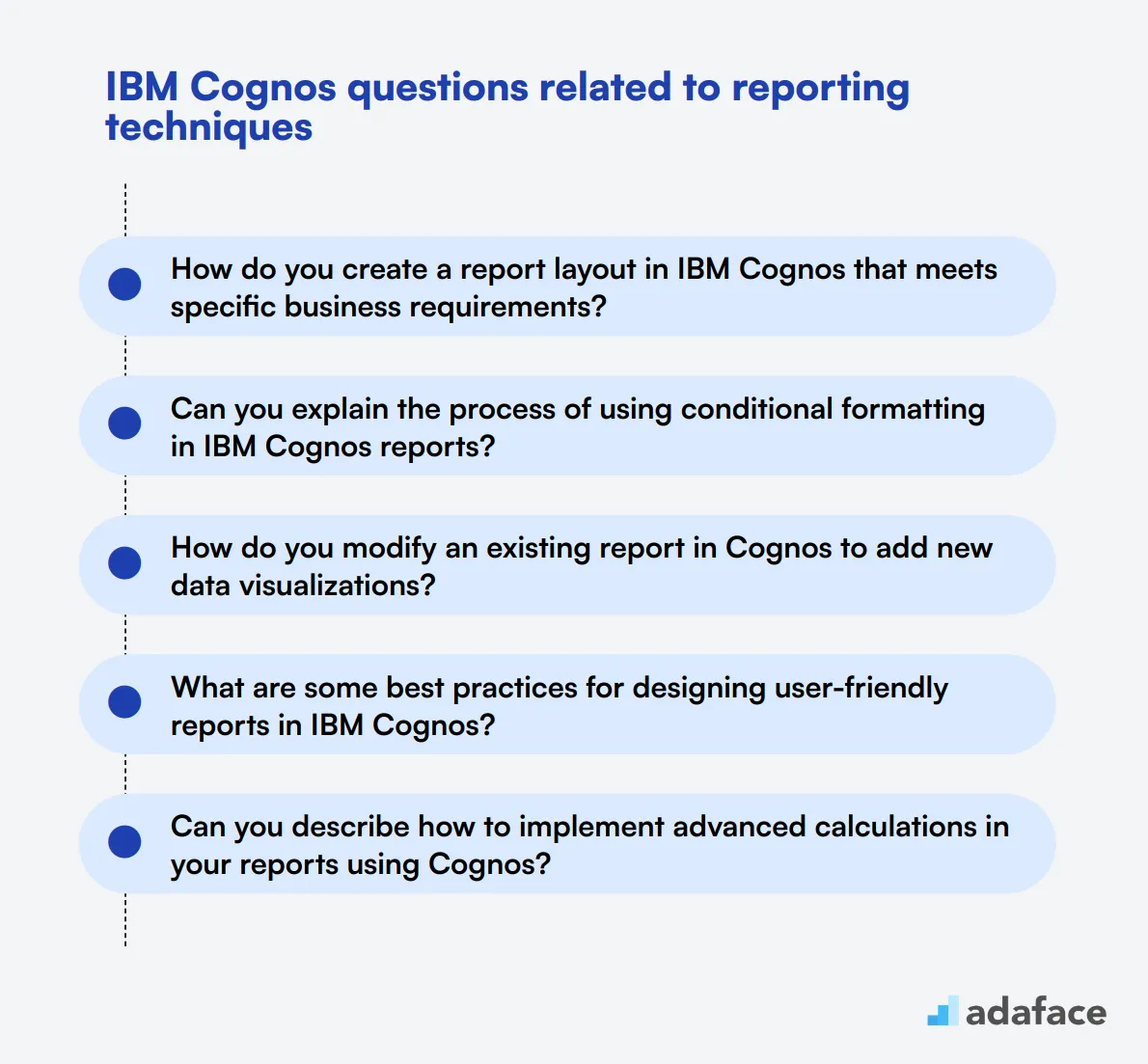
To evaluate a candidate’s proficiency in reporting techniques within IBM Cognos, these targeted questions can reveal their practical skills and knowledge. Use them in interviews to assess if the applicant can successfully tackle real-world reporting challenges they may face in roles like a business intelligence developer or analyst.
- How do you create a report layout in IBM Cognos that meets specific business requirements?
- Can you explain the process of using conditional formatting in IBM Cognos reports?
- How do you modify an existing report in Cognos to add new data visualizations?
- What are some best practices for designing user-friendly reports in IBM Cognos?
- Can you describe how to implement advanced calculations in your reports using Cognos?
- How do you utilize the data items in a report to enhance its informational value?
- What strategies do you employ to optimize report execution times in Cognos?
- Can you explain how to use the report authoring tools in IBM Cognos to create a multi-page report?
- How do you incorporate external data sources into Cognos reports?
- What techniques do you apply to ensure that reports are responsive across different devices?
- Can you describe how to use prompts effectively to filter report data?
- How do you manage report versioning and ensure stakeholders have access to the latest reports?
8 IBM Cognos interview questions and answers related to data modeling
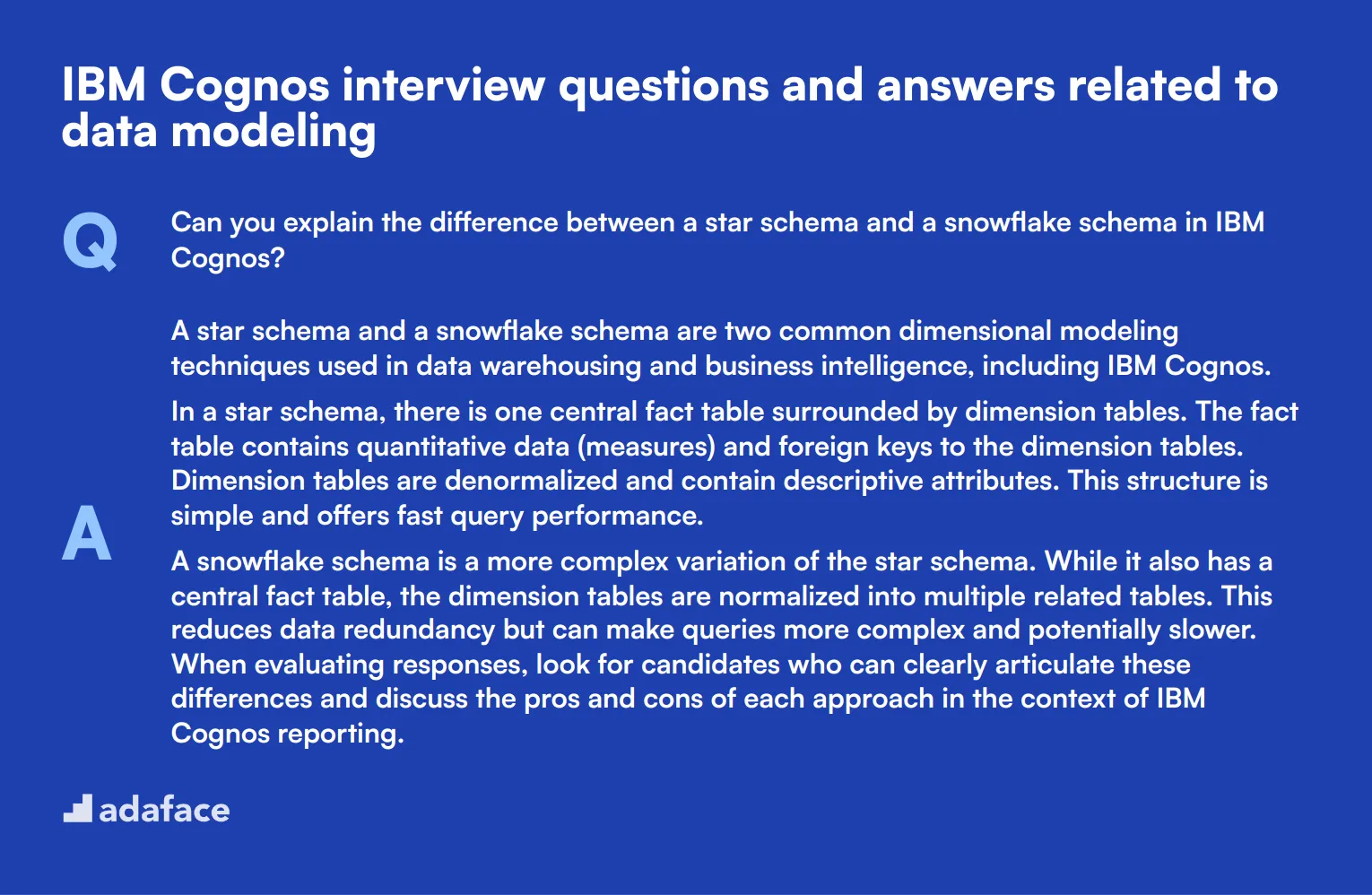
Ready to dive into the world of data modeling in IBM Cognos? These 8 interview questions will help you gauge a candidate's understanding of this crucial aspect of business intelligence. Use them to assess how well applicants can structure data for effective analysis and reporting.
1. Can you explain the difference between a star schema and a snowflake schema in IBM Cognos?
A star schema and a snowflake schema are two common dimensional modeling techniques used in data warehousing and business intelligence, including IBM Cognos.
In a star schema, there is one central fact table surrounded by dimension tables. The fact table contains quantitative data (measures) and foreign keys to the dimension tables. Dimension tables are denormalized and contain descriptive attributes. This structure is simple and offers fast query performance.
A snowflake schema is a more complex variation of the star schema. While it also has a central fact table, the dimension tables are normalized into multiple related tables. This reduces data redundancy but can make queries more complex and potentially slower. When evaluating responses, look for candidates who can clearly articulate these differences and discuss the pros and cons of each approach in the context of IBM Cognos reporting.
2. How would you approach creating a time dimension in IBM Cognos Framework Manager?
Creating a time dimension in IBM Cognos Framework Manager involves several steps to ensure effective time-based analysis:
- Determine the required time granularity (e.g., year, quarter, month, day).
- Create a time dimension table with appropriate attributes (e.g., date, year, quarter, month, day of week).
- Generate time hierarchies (e.g., Year > Quarter > Month > Day).
- Add relevant time-based calculations (e.g., Year-to-Date, Month-over-Month).
- Ensure proper relationships between the time dimension and fact tables.
- Create meaningful names and descriptions for time-related objects.
Look for candidates who demonstrate a structured approach to dimension modeling and understand the importance of time dimensions in business intelligence. They should also mention the significance of creating user-friendly time hierarchies and calculations to facilitate easy report creation and analysis in Cognos.
3. What is a conformed dimension in IBM Cognos, and why is it important?
A conformed dimension in IBM Cognos is a dimension that has the same meaning and content when used in different fact tables across the data warehouse. It allows for consistent analysis across multiple business processes or subject areas.
Conformed dimensions are important because they:
- Ensure data consistency across reports and analyses
- Enable cross-functional reporting and analysis
- Simplify the overall data model
- Reduce data redundancy and maintenance efforts
- Improve query performance by allowing dimension tables to be shared
When evaluating responses, look for candidates who can explain how conformed dimensions contribute to a unified view of the business. They should also be able to discuss strategies for creating and maintaining conformed dimensions in IBM Cognos, such as using a centralized dimension management approach or implementing slowly changing dimension techniques.
4. How do you handle slowly changing dimensions (SCDs) in IBM Cognos?
Handling slowly changing dimensions (SCDs) in IBM Cognos involves implementing strategies to track and manage changes in dimension attributes over time. There are several types of SCDs, but the most common are Type 1, Type 2, and Type 3.
- Type 1 SCD: Overwrite the old value with the new value. This is the simplest approach but loses historical information.
- Type 2 SCD: Add a new row with the updated information, keeping the old row for historical purposes. This preserves history but increases the size of the dimension table.
- Type 3 SCD: Add new columns to store the previous value, allowing for comparison between current and previous states.
Look for candidates who can explain these different SCD types and discuss their implementation in IBM Cognos Framework Manager. They should be able to talk about the pros and cons of each approach and when to use them based on business requirements. Additionally, strong candidates might mention the use of effective dates, current flags, or version numbers to manage SCDs effectively.
5. What is the purpose of a bridge table in IBM Cognos data modeling?
A bridge table in IBM Cognos data modeling is used to resolve many-to-many relationships between dimensions or between a fact table and a dimension. It acts as an intermediate table that breaks down complex relationships into simpler one-to-many relationships.
The main purposes of a bridge table are:
- To represent complex, many-to-many relationships in a dimensional model
- To enable accurate counting and aggregation in scenarios with multiple relationships
- To support flexible and dynamic grouping of dimension members
- To handle scenarios like product bundles, multiple classifications, or changing hierarchies
When evaluating responses, look for candidates who can provide examples of when bridge tables are necessary and how they're implemented in IBM Cognos. They should be able to explain how bridge tables can improve query performance and enable more complex analyses. Strong candidates might also discuss potential challenges in using bridge tables, such as increased model complexity or the need for careful design to ensure accurate results.
6. How do you ensure data consistency across different data marts in IBM Cognos?
Ensuring data consistency across different data marts in IBM Cognos is crucial for maintaining a coherent and reliable business intelligence environment. Here are some key strategies:
- Use conformed dimensions across data marts
- Implement a centralized metadata repository
- Develop and enforce naming conventions and standards
- Create reusable query subjects and calculations
- Utilize parameter maps for consistent code-to-description mapping
- Implement data governance practices
- Regularly audit and reconcile data across marts
- Use a master data management (MDM) approach
Look for candidates who understand the importance of a holistic approach to data consistency. They should be able to explain how these strategies work together in IBM Cognos to create a unified view of the business. Strong candidates might also discuss the challenges of maintaining consistency in a distributed environment and propose solutions like using Framework Manager packages or Cognos cubes to centralize business rules and calculations.
7. What is the role of determinant relationships in IBM Cognos Framework Manager?
Determinant relationships in IBM Cognos Framework Manager play a crucial role in defining how data is aggregated and ensuring the accuracy of calculations. A determinant relationship specifies that the values in one query item determine the values in another query item.
Key aspects of determinant relationships include:
- Defining the granularity of data
- Ensuring correct aggregation of measures
- Preventing double-counting in many-to-many relationships
- Improving query performance by allowing Cognos to optimize SQL generation
- Enabling correct drill-down and roll-up operations in reports
When evaluating responses, look for candidates who can explain how determinant relationships affect report accuracy and performance. They should be able to provide examples of when to use determinant relationships and how to set them up in Framework Manager. Strong candidates might also discuss the relationship between determinants and cardinality, and how they work together to create an accurate and efficient data model.
8. How do you handle ragged or unbalanced hierarchies in IBM Cognos?
Handling ragged or unbalanced hierarchies in IBM Cognos is important for accurately representing complex organizational structures or product categories. Ragged hierarchies have levels with missing members, while unbalanced hierarchies have branches with different depths.
Strategies for handling these hierarchies include:
- Using level-based hierarchies with placeholder members
- Implementing parent-child hierarchies
- Utilizing recursive relationships in the data model
- Creating bridge tables to represent complex hierarchies
- Using MDX expressions for custom hierarchy handling
- Leveraging Cognos Dynamic Cubes for more flexible hierarchy management
Look for candidates who can explain these different approaches and their pros and cons. They should be able to discuss how to implement these solutions in IBM Cognos Framework Manager and Cognos Analytics. Strong candidates might also mention the importance of working closely with business users to understand the nature of the hierarchies and choose the most appropriate representation for reporting and analysis needs.
8 situational IBM Cognos interview questions with answers for hiring top analysts
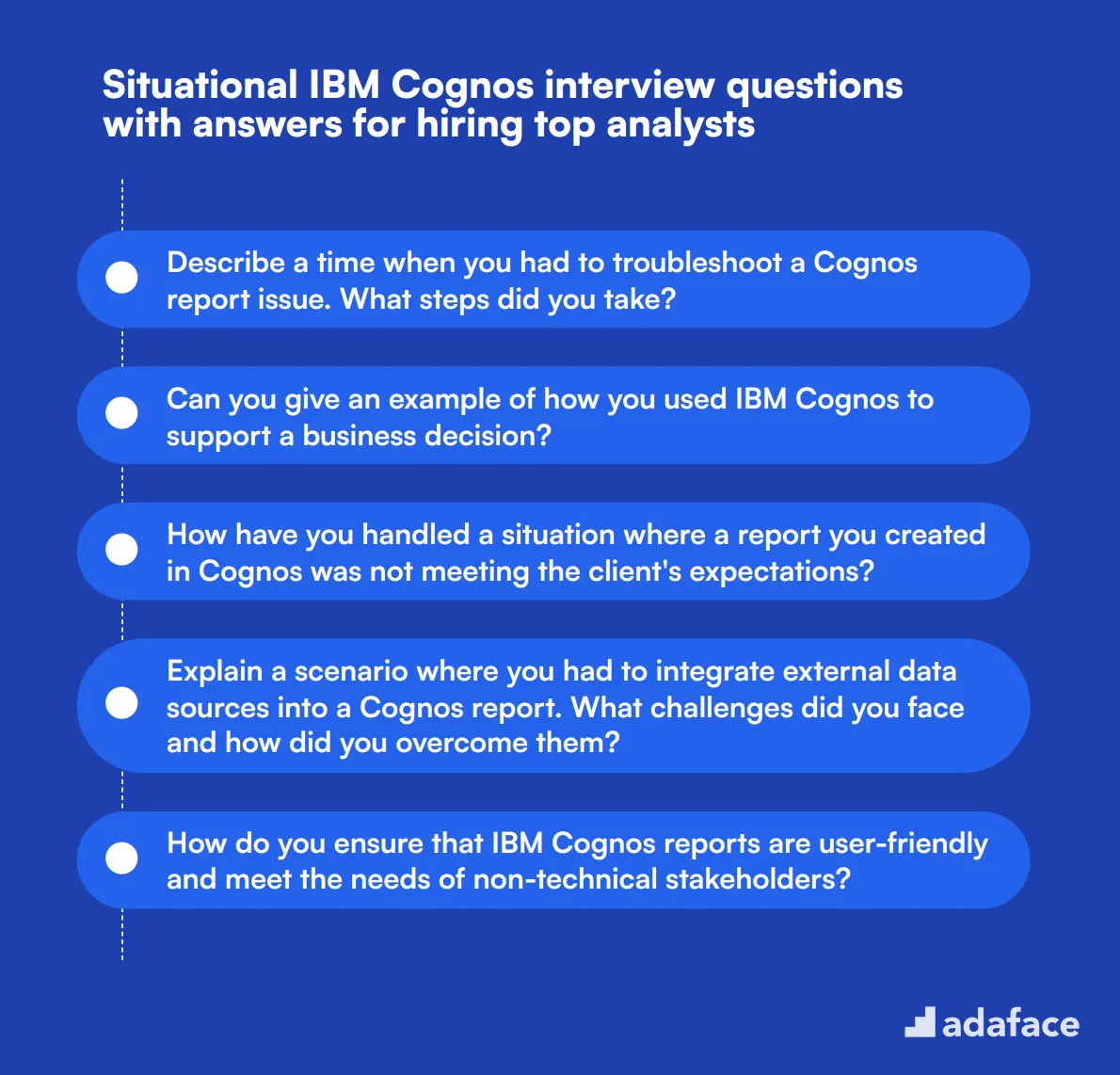
To ensure you're hiring top-notch IBM Cognos analysts, it's crucial to ask the right questions. This list of situational interview questions will help you evaluate how candidates handle real-world scenarios, ensuring they have the problem-solving skills and experience needed to excel in your team.
1. Describe a time when you had to troubleshoot a Cognos report issue. What steps did you take?
When troubleshooting a Cognos report issue, it's important to follow a structured approach. First, I would identify and replicate the problem to understand its scope and impact. Next, I would check the data source and ensure that the data is accurate and up-to-date. If the issue persists, I would review the report's design, including filters and calculations, to identify any discrepancies.
Additionally, I would consult with stakeholders to gather more context about the issue and any recent changes that might have affected the report. Finally, I would implement and test a solution, documenting the steps taken to resolve the issue to prevent future occurrences.
Recruiters should look for candidates who demonstrate a methodical approach to problem-solving, clear communication with stakeholders, and a proactive attitude in documenting and preventing future issues.
2. Can you give an example of how you used IBM Cognos to support a business decision?
In a previous role, I used IBM Cognos to create a sales performance dashboard that provided real-time insights into sales trends and customer behavior. By analyzing this data, the sales team was able to identify high-performing products and underperforming regions. This information was crucial in reallocating resources and adjusting marketing strategies, which ultimately led to a significant increase in sales.
I focused on creating visualizations that were easy to understand and actionable. For example, heat maps and bar charts highlighted key metrics, allowing decision-makers to quickly grasp the insights and take necessary actions.
An ideal candidate should illustrate their ability to turn data into actionable insights, emphasizing their role in the decision-making process and the positive impact of their work.
3. How have you handled a situation where a report you created in Cognos was not meeting the client's expectations?
When a report does not meet client expectations, my first step is to engage with the client to understand their specific concerns and requirements. I would review the report with them to identify any gaps or misalignments with their needs. Once I have a clear understanding, I would make the necessary adjustments to the report's design, data sources, or filters to better align with their expectations.
After implementing changes, I would present the revised report to the client for feedback, ensuring that it meets their needs. Additionally, I would document the client's requirements and the changes made to maintain a clear record for future reference.
Recruiters should look for candidates who demonstrate strong communication skills, a client-focused approach, and the ability to adapt and improve their work based on feedback.
4. Explain a scenario where you had to integrate external data sources into a Cognos report. What challenges did you face and how did you overcome them?
In one project, I had to integrate external data from a third-party CRM system into a Cognos report. The primary challenge was ensuring data compatibility and consistency between the CRM system and our internal databases. I started by understanding the data structure and format of the external source, then mapped it to our existing data model in Cognos.
To overcome challenges related to data quality and format discrepancies, I used ETL (Extract, Transform, Load) processes to clean and standardize the data before loading it into Cognos. I also collaborated with the CRM vendor to set up automated data feeds, ensuring timely and accurate data integration.
Ideal candidates should showcase their problem-solving skills, technical expertise in data integration, and ability to collaborate with external partners to achieve seamless data integration.
5. How do you ensure that IBM Cognos reports are user-friendly and meet the needs of non-technical stakeholders?
To ensure Cognos reports are user-friendly, I prioritize understanding the needs and preferences of non-technical stakeholders. This involves gathering detailed requirements and feedback from users to design reports that are intuitive and easy to navigate. I focus on using clear and concise language, avoiding technical jargon, and incorporating visual elements like charts and graphs to make data interpretation easier.
I also provide user training sessions and create documentation to help stakeholders understand how to interact with the reports effectively. Additionally, I use interactive elements like drill-downs and prompts to allow users to explore the data at their own pace and find the insights they need.
Look for candidates who demonstrate empathy for end-users, a strong understanding of user-centered design principles, and the ability to communicate complex information in an accessible way.
6. Describe a time when you had to manage multiple Cognos reports for different departments. How did you prioritize your tasks?
In a role where I managed reports for multiple departments, prioritization was key. I began by understanding the urgency and importance of each report request through discussions with department heads. I used a priority matrix to categorize tasks based on their impact and deadlines, ensuring that high-priority and time-sensitive reports were addressed first.
To stay organized, I maintained a detailed project tracking system, documenting progress and any dependencies. Regular communication with stakeholders was crucial to managing expectations and keeping everyone informed about the status of their requests.
Recruiters should look for candidates who demonstrate strong organizational skills, effective communication, and the ability to manage multiple priorities without sacrificing quality.
7. How would you approach creating a report that needs to combine historical data with real-time data in Cognos?
Combining historical data with real-time data in Cognos requires careful planning and a robust data architecture. I would start by identifying the data sources for both historical and real-time data. For historical data, I would use a data warehouse or another centralized repository, while for real-time data, I would integrate streaming data sources or APIs.
I would then design a data model that allows seamless integration of both data types, ensuring that the report can query historical data efficiently while also fetching real-time updates. This might involve creating a hybrid architecture that leverages both batch and streaming data processing techniques.
Candidates should emphasize their experience with data integration, understanding of real-time data processing, and ability to design efficient data models that handle both historical and real-time data seamlessly.
8. What strategies do you use to maintain data security and compliance when working with IBM Cognos?
Maintaining data security and compliance in IBM Cognos involves implementing several strategies. First, I ensure that access controls are in place, using role-based permissions to restrict access to sensitive data. This involves setting up user roles and permissions within Cognos Administration to ensure that only authorized personnel can view or modify specific reports and data sets.
I also ensure that data encryption is enabled for data at rest and in transit to protect against unauthorized access. Regular security audits and compliance checks are conducted to identify and address potential vulnerabilities. Additionally, I stay updated with relevant data protection regulations and ensure that all processes and configurations adhere to these standards.
Ideal candidates should demonstrate a strong understanding of data security principles, familiarity with compliance regulations, and experience in implementing security measures within IBM Cognos.
Which IBM Cognos skills should you evaluate during the interview phase?
While it's impossible to assess every aspect of a candidate's IBM Cognos expertise in a single interview, focusing on core skills is key. By evaluating these fundamental areas, you can gain valuable insights into a candidate's proficiency and potential fit for the role.
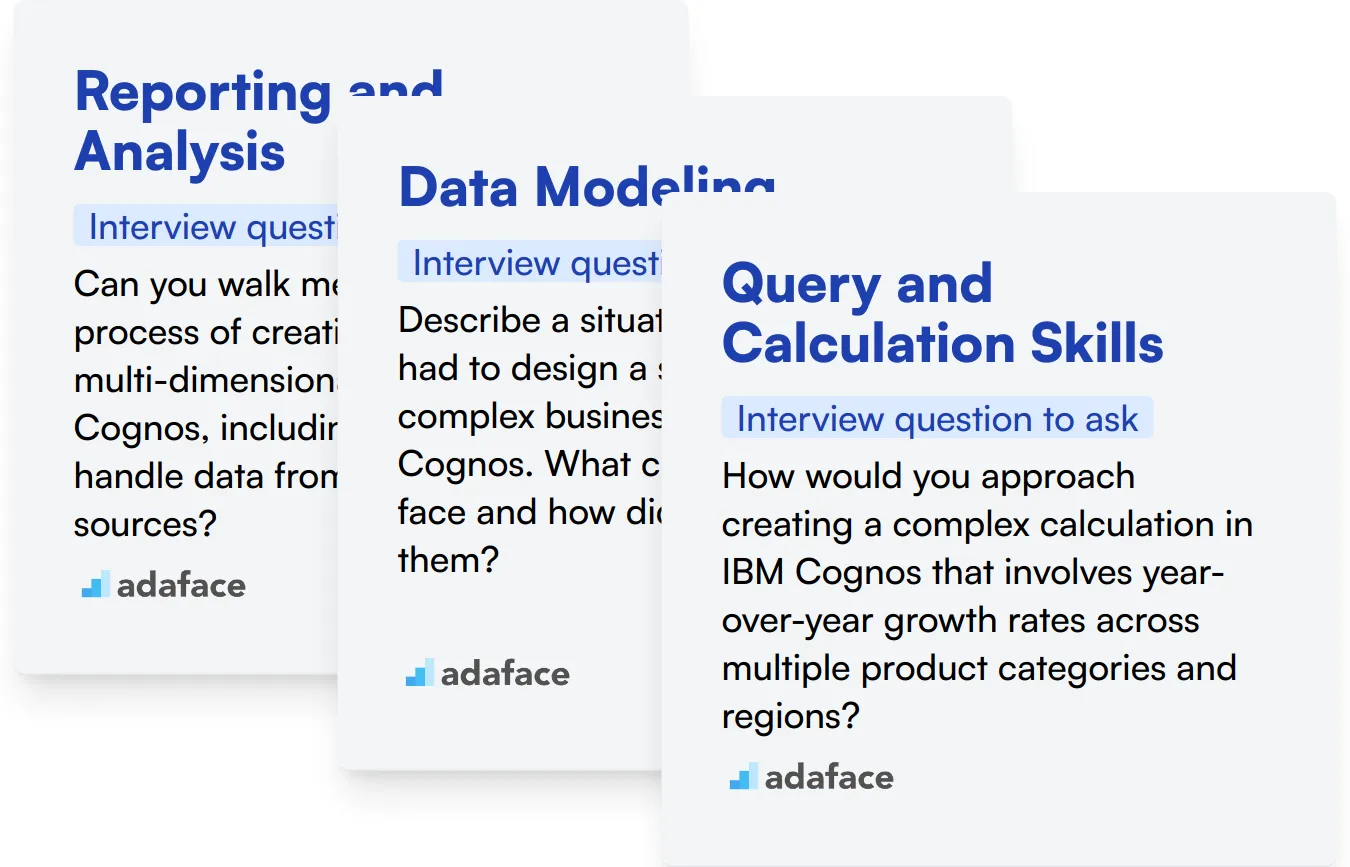
Reporting and Analysis
Reporting and analysis are cornerstone skills in IBM Cognos. They involve creating insightful reports, dashboards, and analytics that drive data-driven decision-making.
Consider using an assessment test with relevant MCQs to evaluate a candidate's reporting and analysis capabilities in IBM Cognos.
To assess this skill during the interview, you can ask targeted questions about report creation and data analysis techniques.
Can you walk me through the process of creating a complex, multi-dimensional report in IBM Cognos, including how you would handle data from multiple sources?
Look for answers that demonstrate a structured approach to report creation, knowledge of data modeling, and familiarity with Cognos-specific features for handling multiple data sources.
Data Modeling
Data modeling is critical in IBM Cognos as it forms the foundation for effective reporting and analysis. It involves structuring data to optimize performance and usability.
An assessment test focusing on data modeling concepts can help filter candidates with strong skills in this area.
During the interview, you can probe the candidate's data modeling expertise with a specific question.
Describe a situation where you had to design a star schema for a complex business scenario in IBM Cognos. What challenges did you face and how did you overcome them?
Pay attention to the candidate's understanding of dimensional modeling, their problem-solving approach, and their ability to align the data model with business requirements.
Query and Calculation Skills
Proficiency in writing queries and creating calculations is essential for extracting and manipulating data effectively in IBM Cognos. This skill enables the creation of meaningful insights from raw data.
To evaluate a candidate's query and calculation skills, consider asking a question that tests their ability to solve a real-world problem.
How would you approach creating a complex calculation in IBM Cognos that involves year-over-year growth rates across multiple product categories and regions?
Look for answers that demonstrate understanding of Cognos calculation syntax, logical thinking in breaking down the problem, and consideration of performance implications.
Hire Top IBM Cognos Experts with Skills Tests and Targeted Interviews
When hiring for IBM Cognos positions, it's important to verify candidates' skills accurately. This ensures you bring on board professionals who can truly contribute to your data analysis and reporting needs.
The most effective way to assess IBM Cognos skills is through targeted skills tests. Consider using our Business Intelligence Analyst Test or Data Analysis Test to evaluate candidates' proficiency.
After administering these tests, you can shortlist the top performers for interviews. Use the interview questions provided in this post to further evaluate their knowledge and problem-solving abilities in IBM Cognos.
Ready to streamline your hiring process for IBM Cognos experts? Sign up for Adaface to access our comprehensive suite of assessment tools and find the best talent for your team.
Business Intelligence Analyst Test
Download IBM Cognos interview questions template in multiple formats
IBM Cognos Interview Questions FAQs
Basic questions can include topics like the fundamentals of Cognos, its architecture, and its main features.
Focus on entry-level questions about their experience with Cognos, basic reporting tasks, and general data handling.
Intermediate questions can cover more complex data modeling, report optimization, and scenarios requiring problem-solving skills.
Situational questions can include scenarios involving troubleshooting, optimizing report performance, and handling large data sets.
Questions should assess understanding of data models, star schema vs snowflake schema, and the candidate’s experience with Framework Manager.
Ask about specific reporting tools within Cognos, their experience with creating dashboards, and their ability to customize reports based on user requirements.

40 min skill tests.
No trick questions.
Accurate shortlisting.
We make it easy for you to find the best candidates in your pipeline with a 40 min skills test.
Try for freeRelated posts
Free resources




